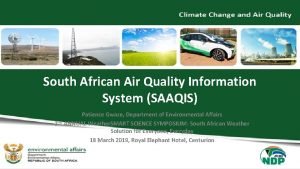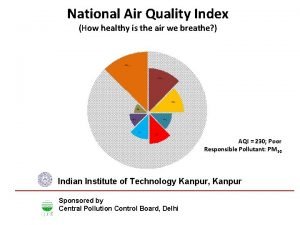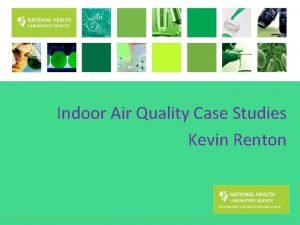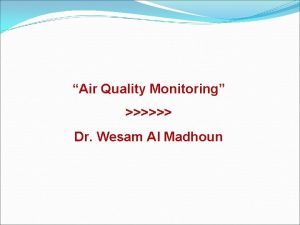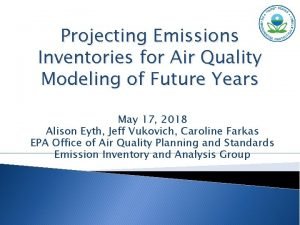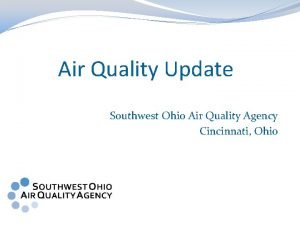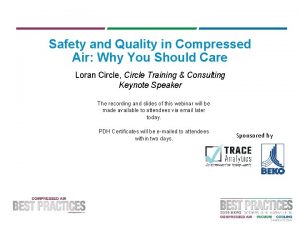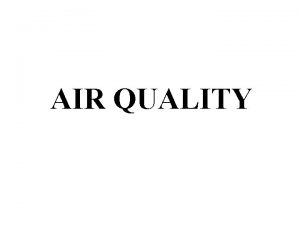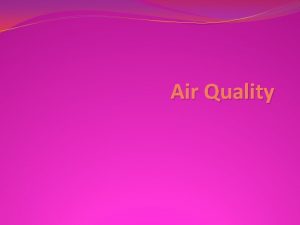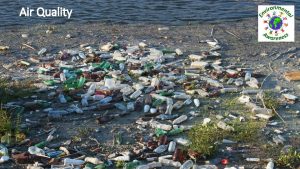Maryland Air Quality Report Page 2002 Status Report






































- Slides: 38

Maryland Air Quality Report Page 2002 Status Report and Long-Term Trends

Page A Message from the Secretary In May 2003, I became Acting Secretary of the Department of the Environment. One of my first orders of business concerned an air pollution matter at the national level involving a long-term proposal for helping states comply with the new federal 8 -hour ozone standard. My involvement with this matter led me to question whether Maryland’s air is cleaner today than it was 20 years ago. The answer to this question is important to me as a citizen of Maryland, for I recognize that poor air quality can affect not only my health, but also the health of all Marylanders. The answer is also important to me in my role as a government official responsible for shaping public policy on Maryland’s environment, for we have made great strides in controlling sources of air pollution and it is critical to know whether such efforts have resulted in cleaner air. If air quality has not improved, a shift in strategy may be needed. The report you are about to read summarizes twenty years of air quality data. The summaries answer the question I posed to myself earlier this year. I am happy to report that the answer I received is a positive one. Yes, the air is cleaner today than it was twenty years ago. Specifically, for some pollutants, like lead and carbon monoxide, significant improvements have been made. For one pollutant in particular, ground-level ozone, the story is one of measured success – progress has been made, but more is needed if we are to have ozone free summers in Maryland. The overall progress that has been made with respect to Maryland’s air quality has been achieved with the help of many – local governments, the Environmental Protection Agency, industries, small businesses, environmental groups, academia and the general public to name a few. All deserve a note of thanks. Unfortunately, our job is not done, for as I noted above summertime ozone remains a problem. In order to effectively solve this problem, Maryland needs help. Much of our ozone problem is the result of pollutants being transported into Maryland from other states west and south of us; and, unless these states reduce pollutant levels, clean air will remain an elusive goal. Every citizen of Maryland deserves clean air, and the Department of the Environment will continue to work to make this a reality. Existing air pollution control programs will continue to be implemented, new programs will be instituted and, to address pollutants generated outside Maryland’s borders, new federal/state partnerships will be forged. As I said earlier, many have played a role in the progress we have made so far. Continued involvement is needed if we are to overcome our remaining challenges. With your help I am confident that we will be successful in providing every Marylander clean air.

Table of Contents Section 1: Introduction to Air Quality (Air quality issues in Maryland) Section 2: Highlights. Trends, and Issues Section 3: EPA Criteria Pollutant Information Section 4: Ozone Section 5: Particulate Matter Section 6: Sulfur Dioxide Section 7: Nitrogen Dioxide Section 8: Carbon Monoxide Section 9: Lead Page http: //www. urbanrivers. org/web_images/bayscene. gif www. mdarchives. state. md. us

Section 1: Air Quality 101 Millions of people live in areas where ground level ozone, very small particles, and toxic pollutants pose health concerns. Air pollution can impact our health over short periods of time or accumulate in our systems to pose chronic health concerns. When people have a short-term exposure to air pollutants above certain levels, they may experience temporary health concerns, such as eye irritation, throat irritation and difficulty breathing. Exposure to air pollution may also trigger attacks of pre-existing lung conditions such as asthma. Long-term exposure to air pollution cause or aggravate chronic health concerns, such as cancer and damage to the body's immune, neurological, reproductive and respiratory systems. Air pollution is not just a problem found in our cities. The air pollution that we create can cover large geographic areas and remain in the environment for long periods of time. These air pollutants can also be carried hundreds of miles by winds and can affect distant areas far from the source of the pollution. General Air Quality The overall trend is that air quality has been improving in Maryland. For example, during the 1980's, Maryland averaged 20 days a summer when ground level ozone exceeded the federal health standard (Code Red conditions). Maryland averaged 10 such days during the 1990's. Also, when Code Red conditions do exist, the peak ozone values are lower over the years and the duration of the peaks have lessened. The ability to avoid Code Red conditions when the temperature reaches or exceeds ninety degrees has also improved. These improvements can be attributed to the fact that Maryland has adopted all federal pollution reduction measures contained in the Clean Air Act, implemented numerous local pollution control programs, and has gained help from the local community in limiting pollutionforming activities on days when Code Red conditions are forecasted. In addition to ozone, significant reductions have been made with respect to the concentration of lead and carbon monoxide in the air, mostly as a result of improvements made to gasoline. Page While many improvements have been made, much work still needs to be done. Maryland has not achieved the federal one-hour ground-level ozone standard, and must do so by November 2005. A significant factor in this regard is ozone transported into Maryland from states upwind of us. Ozone-forming pollutants from power plants and large industrial sources located in the Ohio River Valley are carried to Maryland by upper atmospheric winds. This and other forms of transported pollution must be reduced if Maryland is to have clean air.

Section 2: Highlights Long-term trends • When viewed long term, some positive trends emerge: • With the elimination of lead in gasoline, lead levels are virtually nonexistent • Through the use of oxygenated fuels, carbon monoxide levels are now within federal standards • Levels of coarse particulate matter, sulfur dioxide and nitrogen dioxide have been and continue to remain well below federal standards • For ozone: • Weather continues to play a major role in the formation of ozone • Peak values are dropping • The duration of ozone violations appear to be dropping • The ability to not violate when the temperature exceeds 90º is improving 2002 Highlights • 1 -Hour Ozone - an unseasonably high summer of 2002 led to 16 exceedences of the onehour ozone standard • 8 -Hour Ozone – many more violations than the 1 -hour standard (this is a more difficult standard to meet) • PM Fine – In 1997 the EPA established a new standard for Fine Particulate Matter – in 2000 MDE started collecting monitoring data for Fine Particles – three years of monitoring data is required to establish whether Maryland is in attainment or nonattainment of the new standard – in 2002, MDE started looking at the first three-year averages, and portions of Maryland are showing values above the new standard Page

Future Issues • 8 Hour Ozone – new standard, 2002 and earlier monitoring efforts concluded that this standard will be more difficult to meet than the 1 -hour standard • Fine Particulate Matter (PM 2. 5) - portions of Maryland will be unable to meet this new standard • There will be an increased emphasis on data gathering and mathematical modeling to better understand the science of air pollution • There will be an increased need to work with regional organizations to bring about regional reductions in air pollution so that Maryland can achieve compliance with federal ozone and fine particulate matter standards Western Maryland – Photo: MDE Page

Section 3: EPA Criteria Pollutant Information National Ambient Air Quality Standards The federal Clean Air Act (CAA) requires the EPA to set primary National Ambient Air Quality Standards (NAAQS) for air pollutants that are considered harmful to public health and the environment. These pollutants are known as criteria pollutants. Currently, NAAQS exist for six criteria pollutants -- ground level ozone, particulate matter, carbon monoxide, sulfur dioxide, lead and nitrogen dioxide. The primary NAAQS are defined as the levels of air quality that the EPA judges necessary to protect the public health. EPA also establishes secondary NAAQS that protect the public welfare from any known or anticipated adverse effects. The CAA also requires that, once established, each NAAQS is to be reviewed and, if deemed necessary, revised every five years in order to ensure that it reflects the most recent health information available. The most recent re-review led to EPA establishing two new standards: an 8 -hour ozone standard set at 80 parts per billion (versus a 1 -hour standard set at 120 parts per billion) and a particulate matter standard for particles 2. 5 microns or smaller (versus the previous standard for particles 10 microns or smaller). EPA found the new standards to be necessary, for new health studies involving ozone showed that adverse health effects occur at levels below the 120 parts per billion level and that exposures for longer than one hour are of concern. The EPA also found that particulate matter of smaller size was important, for such particles had the highest potential to lodge deep inside the lungs and damage lung tissue. Page Green Ridge State Park, Allegany County, MD

EPA Criteria Pollutant Information Maryland is in attainment for the following criteria pollutants: • Carbon Monoxide • Lead • Nitrogen Dioxide • Particulate Matter 10 • Sulfur Dioxide Portions of Maryland have air quality that does not meet the ambient air quality standards for: • 1 -hour ozone • 8 -hour Ozone • PM 2. 5 Photo: NOAA Page

Section 4: Ozone Graphics: EPA Ozone is a colorless, odorless gas formed when nitrogen oxides and volatile organic compounds react in the presence of intense sunlight. OZONE FORMATION Ozone is formed when nitrogen oxides (from fuel burning sources like utilities and automobiles) and volatile organic compounds (from sources such as gasoline, paints, inks and solvents) react in the presence of sunlight. These two categories of pollutants are also referred to as ozone precursors. The formation of ozone is dependent on the volume of air available for dilution, air temperature and the amount of sunlight. Page

SOURCES Nitrogen oxides are emitted from fuel burning sources including electric utilities, industrial boilers and vehicles. Sources of volatile organic compounds include paints, inks, solvents and gasoline. HEALTH EFFECTS • Ozone can irritate the respiratory system, causing coughing, throat irritation, and chest pains. • Ozone can reduce lung function and make it more difficult to breathe deeply and vigorously. • Ozone can aggravate asthma. One reason this happens is that ozone makes people more sensitive to allergens, the most common triggers of asthma attacks. • Ozone can increase susceptibility to respiratory infections. • Ozone can inflame and damage the lining of the lungs. Within a few days, the damaged cells are shed and replaced—much like the skin peels after a sunburn. • Animal studies suggest that if this type of inflammation happens repeatedly over a long time period (months, years, a lifetime), lung tissue may become permanently scarred, resulting in less lung elasticity, permanent loss of lung function, and a lower quality of life. • Children are at even greater risk, because their respiratory systems are developing, they're more active and spend more time out of doors, and kids breathe in more air per pound of body weight than do adults. • People with respiratory diseases that make their lungs more vulnerable to ozone may experience health effects earlier and at lower ozone levels than less sensitive individuals. Page

The 2002 Ozone Monitoring Network Page Map: MDE

Maryland 1 -hour Ozone Nonattainment: Maryland is currently in nonattainment for the 1 -hour ozone standard (portions of Maryland are in nonattainment – not the entire state as a whole). The map below shows the 1 -hour nonattainment boundaries for Maryland. Areas that are nonattainment (have ozone levels above the standard) are shaded in red and yellow. When an area is identified as being nonattainment it is then classified by how high the ozone concentrations actually are. Both the Baltimore Region (including Cecil County) and the Washington DC Region are classified as “severe” nonattainment areas - meaning the ozone levels are relatively high. 1 -hour Ozone Nonattainment Areas Severe Serious Marginal Ozone Transport Region Page Map: MDE

Number of Days MD Violated the 1 -Hour Ozone Standard Page Interesting Note: when you divide the annual total # of hours above the standard by the annual total of exceedences for 2002, the result is 5. 7 hours per exceedence, when compared with other high exceedence years like 1995, 1997, and 1999 this value is lower than in the past (1995 = 8. 0, 1997 = 9. 6, 1999 = 8. 5) Data: MDE

2002 Ozone Summary - Maryland The first ozone exceedance of the one-hour standard for Maryland’s 2002 ozone season occurred on June 10 th and the last “Bad Air Day” occurred on September 9 th. In between, the worst stretch of “Bad Air Days” occurred from August 3 rd – 14 th, when 7 out of 12 days experienced Code Red air quality conditions. From a historical viewpoint, the 2002 summer was above average for ozone with 16 days exceeding the 1 -hour ozone standard. 2002 Ozone Summary – Other States Other states in the Mid Atlantic/Northeast region also experience ozone problems each summer. The chart below shows how Maryland fared in 2002 relative to these other states. Page Data: EPA

2002 Weather Summary Hot and dry would be an apt description of the 2002 ozone season (May – September). On the hot side, Maryland had 46 days in which the high temperature reached or exceeded 90 degrees (the normal summer average is 30 days). On the dry side, rainfall was approximately 4. 9 inches below normal. The combination of high temperatures and continued lack of rain did nothing to help alleviate Maryland’s drought. Why were there so many days above 90 degrees and little rain? The culprit was an area of high pressure that forms off the coast of Maryland in the Atlantic Ocean, and is often referred to as the Bermuda High. During the summer of 2002, the Bermuda High stayed close enough to create hazy, hot, and humid weather for Maryland. Why is this weather pattern of interest? Simply put, the lack of rain and the high temperatures never gave the region an opportunity to “wash out” air pollution, both home-grown and transported in from other states. Stagnant weather conditions in combination with high temperatures and low rainfall create the best weather scenario for ozone production. From a pollution generation perspective, it is important to note that a Bermuda High creates southwesterly to northwesterly winds relative to Maryland, which means that Maryland’s air has traveled over the mid-west (specifically, the Ohio River Valley) before arriving here. The mid-west is home to many large coal-fired power plants. As such, under Bermuda High conditions, the emissions of ozone-forming pollutants from these plants and the ozone that has been created as a result of these emissions are delivered to Maryland along upper level wind currents. Page Two “Bad Air Days” which occurred in July were the result of the wildfires burning out of control in northern Quebec, Canada near the shores of St. James Bay. Upper level winds transporting smoke and haze from northern Quebec into Maryland combined with light surface winds and hot temperatures to cause dramatic increases in ozone just north of Baltimore.

Maryland’s Progress in Controlling Ozone Although exceedences of the one-hour, health-based ambient air quality ozone standard continue to occur throughout much of Maryland, the monitored one-hour ozone levels show a general downward trend when viewed long term. It is difficult to draw conclusions by comparing one year of exceedance data to another because of the impact of differing meteorological conditions. Generally, however, both the number and the severity of ozone exceedences, as measured by our monitoring stations, have decreased somewhat. As stated previously, simply tracking the number of exceedences over time is insufficient for the purpose of showing whether any real progress is being made relative to ozone air quality. Other information, such as the degree and the pervasiveness of ozone exceedences is needed. The chart below provides information on the degree to which the ozone standard was exceeded each year. It also gives a sense of scale to the pervasiveness of the ozone problem by showing how many stations over the course of the ozone season exceeded the standard. Overall, the chart shows that the State has made some progress in addressing ozone, particularly in the past few years. The peak exceedance values are somewhat lower now than in earlier years and the total number of stations experiencing exceedences of the standard as well as higher values are dropping. Page Note: The numbers in the columns denoting number of stations reflect a cumulative total (for example, five stations exceeding for six days yields a 30 on the chart) - 2002 values are currently being reviewed by USEPA

Temperatures and Ozone High temperatures are the single greatest factor in creating ozone. The top plot shows high temperatures continue to occur with normal environmental variability. However, the bottom plot shows fewer ozone exceedance days despite the high temperatures. Page Maryland shows steady improvement in the number of ozone exceedance days with respect to the number of high temperature days.

Ozone Design Values – mapping our improvements 1988 1 -hour Ozone Design Values Units: ppb 2002 1 -hour Ozone Design Values Design Value: a statistical method of averaging air monitoring data Page Maps: MDE Units: ppb

How about 8 -Hr Ozone? 2002 8 -Hr Ozone Highlights 2002 8 Hour Peak Values (8 Hour Average) • • • Page 2002 8 -Hr Summary Number of ozone exceedance days: 41 Max concentration: 128 ppb at the Edgewood monitor on June 24, 2002 (8 -hr standard is 85 ppb) All 16 ozone monitors exceeded the 8 -hr ozone standard Map: MDE

Section 5: Particulate Matter The term “particulate matter” (PM) includes both solid particles and liquid droplets found in air. Many manmade and natural sources emit PM directly or emit other pollutants that react in the atmosphere to form PM. These solid and liquid particles come in a wide range of sizes. Particles less than 10 micrometers in diameter tend to pose the greatest health concern because they can be inhaled into and accumulate in the respiratory system. Particles less than 2. 5 micrometers in diameter are referred to as “fine” particles. Sources of fine particles include all types of combustion (motor vehicles, power plants, wood burning, etc. ) and some industrial processes. Particles with diameters between 2. 5 and 10 micrometers are referred to as “coarse. ” Sources of coarse particles include crushing or grinding operations, and dust from paved or unpaved roads. EXAMPLES Dust, ash, mist, smoke and fumes SOURCES Fuel burning, industrial operations, incinerators, agricultural tilling and motor vehicles HEALTH EFFECTS Both fine and coarse particles can accumulate in the respiratory system and are associated with numerous health effects. Coarse particles can aggravate respiratory conditions such as asthma. Exposure to fine particles is associated with several serious health effects, including premature death. Adverse health effects have been associated with exposures to PM over both short periods (such as a day) and longer periods (a year or more). When exposed to PM, people with existing heart or lung diseases—such as asthma, chronic obstructive pulmonary disease, congestive heart disease, or ischemic heart disease—are at increased risk of premature death or admission to hospitals or emergency rooms. Page

The elderly also are sensitive to PM exposure. They are at increased risk of admission to hospitals or emergency rooms and premature death from heart or lung diseases. When exposed to PM, children and people with existing lung disease may not be able to breathe as deeply or vigorously as they normally would, and they may experience symptoms such as coughing and shortness of breath. PM can increase susceptibility to respiratory infections and can aggravate existing respiratory diseases, such as asthma and chronic bronchitis, causing more use of medication and more doctor visits. PUBLIC WELFARE EFFECTS On Plants : Particulate matter can form a film on plant leaves reducing sunlight and subsequently interfering with photosynthesis and plant growth. On Property Other effects of particles include soiling and degradation of property, which can be costly in terms of cleaning and maintaining surfaces. 1999 PM 2. 5 Source Apportionment in Maryland On Visibility Reduction of visibility occurs when small particles absorb or scatter visible light. Visibility is a national and statewide concern, particularly in Recreational settings such as national parks, historical sites and other scenic attractions. Page Data: MDE - PEI

MDE 2002 PM 2. 5 Network – 3 yr. (2000 -2002) Annual Design Values See Insert Map Units: ug/m 3 Page Design Value: a statistical method of averaging air monitoring data Map: MDE – Data are preliminary – several monitor locations did not have USEPA required quarterly sample totals

MDE 2002 PM 2. 5 Network – 3 yr. (2000 -2002) Annual Design Values Units: ug/m 3 Page Map: MDE – Data are preliminary – several monitor locations did not have USEPA required quarterly sample totals Design Value: a statistical method of averaging air monitoring data

PM 2. 5 Data for Neighboring States Page State # Monitors # Exceeding Standard % Exceeding Max Standard Value (ug/m 3) VA 18 1 5. 6 16. 1 NY 53 7 13. 2 21. 7 NJ 19 4 21. 1 17. 5 N. C. 41 12 29. 3 17. 3 DEL 11 4 36. 4 16. 7 PA 42 19 45. 2 23. 4 MD 19 10 52. 3 17. 8 WVa 17 12 70. 6 17. 8 Data: EPA

NAAQS – National Ambient Air Quality Standard Glen Burnie – MDE Monitoring Site Page FMC – MDE Monitoring Site Data: MDE

Section 6: Sulfur Dioxide is a gaseous compound of sulfur and oxygen. scidiv. bcc. ctc. edu SOURCES Burning of fossil fuels, including fuels used in vehicles, containing sulfur compounds. Sulfur dioxide can be transformed into other products such as fine particulate sulfates and sulfuric acid mist. HEALTH EFFECTS The most obvious health effects are irritation and inflammation of body tissues that are contacted by the gas. Sulfur dioxide can increase the severity of existing respiratory diseases such as asthma, bronchitis and emphysema. It also constricts air passages making it difficult to breathe. PUBLIC WELFARE EFFECTS On Vegetation : Sulfur dioxide can damage many different types of vegetation. The injury can occur between the veins and on the margins and produces a bleached appearance. Many plants of economic importance are sensitive to sulfur dioxide including potatoes, cucumbers, peas, gladiolus, tulips, grass and several types of trees. On Visibility : Sulfur dioxide can also reduce levels of visibility. Sulfates are a major component of atmospheric fine particulate material. Because some sulfates have a water absorbing capacity, their impact on visibility is greatly increased at high humidities. On Rain : Acid rain is suspected to be caused by sulfur dioxide. Acid rain can lower the p. H of soils and natural waters, cause mineral leaching, damage vegetation and deplete fish populations in some lakes and streams. Page

The 2002 SO 2 Monitoring Network Map: MDE Page

NAAQS – National Ambient Air Quality Standard Riviera Beach – MDE Monitoring Site Page Data: MDE

Section 7: Nitrogen Dioxide is a reddish-brown gas made of nitrogen and oxygen. www. in. gov/idem/air FORMATION Nitrogen Dioxide (NO 2) is produced when nitric oxide (NO) combines with oxygen in the atmosphere. In addition to being a criteria pollutant, nitrogen dioxide is also a precursor for ozone and contributes to acid rain. SOURCES Nitric oxide (NO), which is needed for the formation of nitrogen dioxide (NO 2), is produced during high temperature combustion of fossil fuels in electric power generating facilities, industrial operations, automobiles and chemical processing plants. HEALTH EFFECTS Nitrogen dioxide can directly affect a human’s health by causing acute bronchitis or pneumonia and by causing a lowered resistance to respiratory infections. Long term exposure can also cause chronic lung impairment. Because it is a precursor for ozone, it indirectly affects a human’s health as well. PUBLIC WELFARE EFFECTS On Plants : Some types of vegetation are sensitive to nitrogen dioxide including oats, alfalfa, tobacco, peas and carrots. The one primary symptom of chronic NO 2 exposure is chlorosis or the yellowing of the leaves. Acute exposure can result in gray-green water soaked areas on the upper leaf surface and later the appearance of lesions on the leaves. Because nitrogen dioxide is a precursor for acid rain, it can affect both terrestrial and aquatic vegetation. Page On Visibility Nitrogen dioxide is a reddish-brown gas thought to contribute to a significant proportion of the brownish coloration often observed in polluted air in colder months

The 2002 NO 2 Monitoring Network Map: MDE Page

NAAQS – National Ambient Air Quality Standard Old Town – MDE Monitoring Site Page Essex – MDE Monitoring Site Data: MDE

Section 8: Carbon Monoxide is a colorless, toxic gas composed of carbon and oxygen. SOURCES Combustion of carbon containing materials such as coal, oil, refuse or gasoline; 77% of nationwide CO emissions come from transportation sources. Other major sources are wood burning stoves, incinerators and industrial sources. HEALTH EFFECTS Breathing carbon monoxide affects the oxygen carrying capacity of the blood, even in otherwise healthy individuals. Low concentrations can affect mental function, vision and alertness. High concentrations can increase fatigue and reduce work capacity. Chronic exposure can adversely affect fetal development and can cause heart damage. PUBLIC WELFARE EFFECTS On Animals: Although carbon monoxide has not been found to adversely affect vegetation or materials, it can affect animals in the same manner that it affects humans. Sources of CO – 1990 Inventory Page Data: MDE

The 2002 CO Monitoring Network Map: MDE Page

Conquering CO in Maryland • • • Engine emission controls have led to a vast reduction in auto CO emissions Reformulated fuels have also reduced CO Maryland met Federal standard in 1990 (1995 officially) 1999 concentrations of CO were found to be the lowest of the past 20 years Between 1990 and 1999 exceedances of the national standard decreased 93% Total Number of Exceedances of the CO Standard Baltimore City 1982 - 1994 Number of Exceedances Data: MDE 1982 Page 1987 1994 Data: MDE

NAAQS – National Ambient Air Quality Standard Old Town – MDE Monitoring Site Page Data: MDE

Section 9: Lead compounds can exist in the form of gases or particles in the atmosphere SOURCES Significant lead emissions can come from certain industrial processes. They can also come from sandblasting bridges, overpasses and water tanks. Lead-based paints and leaded gasoline, where available, are also considered sources. HEALTH EFFECTS Lead can harm many of the major systems in the human body including the nervous, renal (kidney) and cardiovascular systems. It can accumulate in the body causing severe reactions such as brain disease and anemia; long-term exposure can eventually result in fatal reactions. Lead is especially harmful to children. EXPOSURE Exposure can occur through inhalation of air and through ingestion of food, water, soil or dust containing lead compounds. A recent survey from the National Health and Nutrition Examination Survey reported a 78% decrease in blood lead levels between 1976 and 1980 and from 1988 to 1991. This dramatic decline is the result of reducing leaded gasoline and the removal of lead from soldered cans. Page Monitoring Trailer: Millington, Maryland

The 2002 Lead Monitoring Network Map: MDE Page

Units: ug/m 3 Success Story: Lowering Lead Levels • Page • Maryland has successfully reduced the amount of lead in the air to well below the national standard The removal of lead from gasoline allowed States like Maryland to make rapid progress Data: MDE
 Hubungan air dengan tanah
Hubungan air dengan tanah Status progress report
Status progress report Edward kuwera
Edward kuwera Ramstein airshow crash
Ramstein airshow crash Apa format tittle page
Apa format tittle page Measure page quality
Measure page quality Quality assurance vs quality control
Quality assurance vs quality control Pmp quality management
Pmp quality management Pmp gold plating
Pmp gold plating Quality assurance cycle in nursing
Quality assurance cycle in nursing Compliance vs quality
Compliance vs quality Basic concept of quality management
Basic concept of quality management Juran's three role model
Juran's three role model Crosby quality is free
Crosby quality is free What is tqm
What is tqm Asu academic status report
Asu academic status report Work status report from doctor
Work status report from doctor Code purple kaiser
Code purple kaiser Enter vendor name
Enter vendor name Convercent report status
Convercent report status Seo progress report
Seo progress report Triennial status report
Triennial status report Training status report
Training status report Oags dashboard
Oags dashboard Annual status of education report
Annual status of education report Survey status report
Survey status report 2020 hydropower status report
2020 hydropower status report Status report
Status report Status report executivo
Status report executivo South african air quality information system
South african air quality information system Air quality index calculation
Air quality index calculation Renton air quality
Renton air quality Ambient air quality standards
Ambient air quality standards St louis air quality
St louis air quality Texas air quality permits
Texas air quality permits Oaops
Oaops Southwest ohio air quality
Southwest ohio air quality Air quality
Air quality Sao paulo air quality
Sao paulo air quality





























